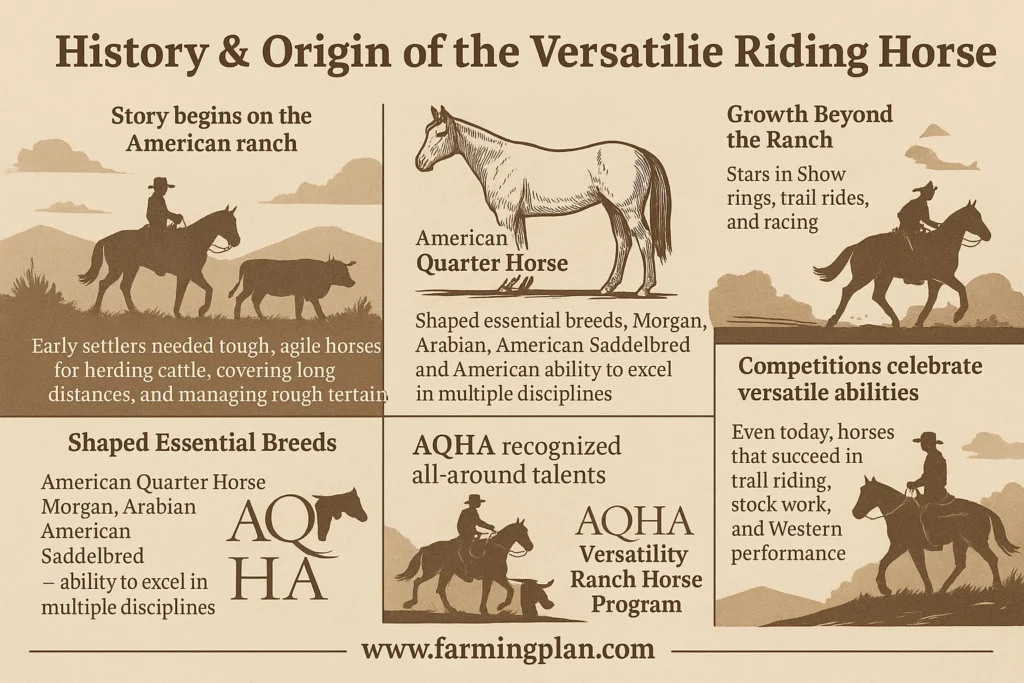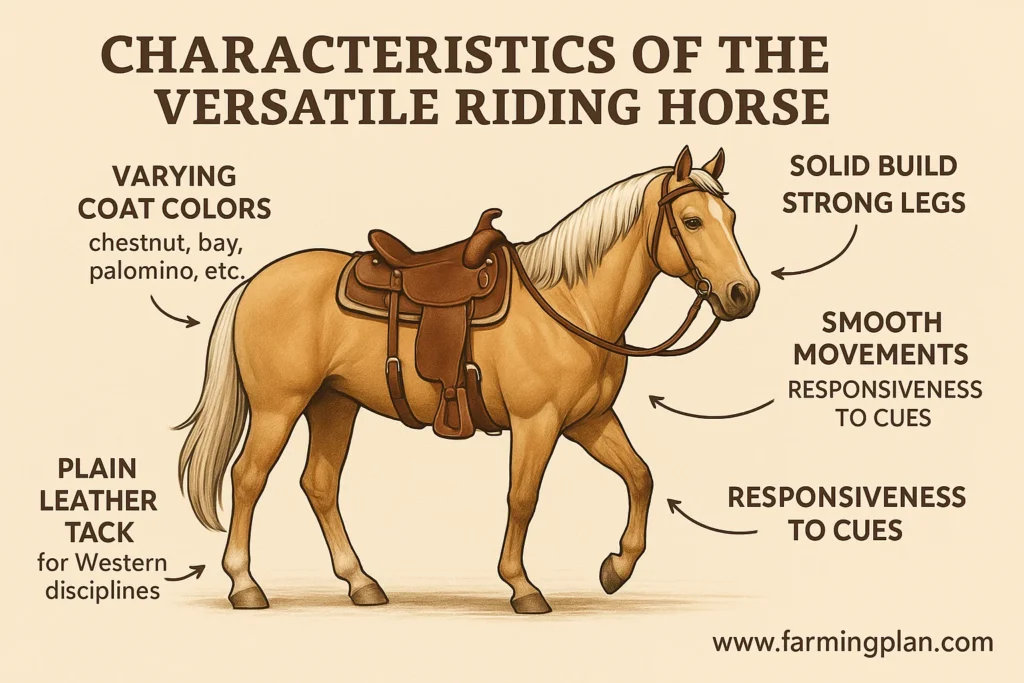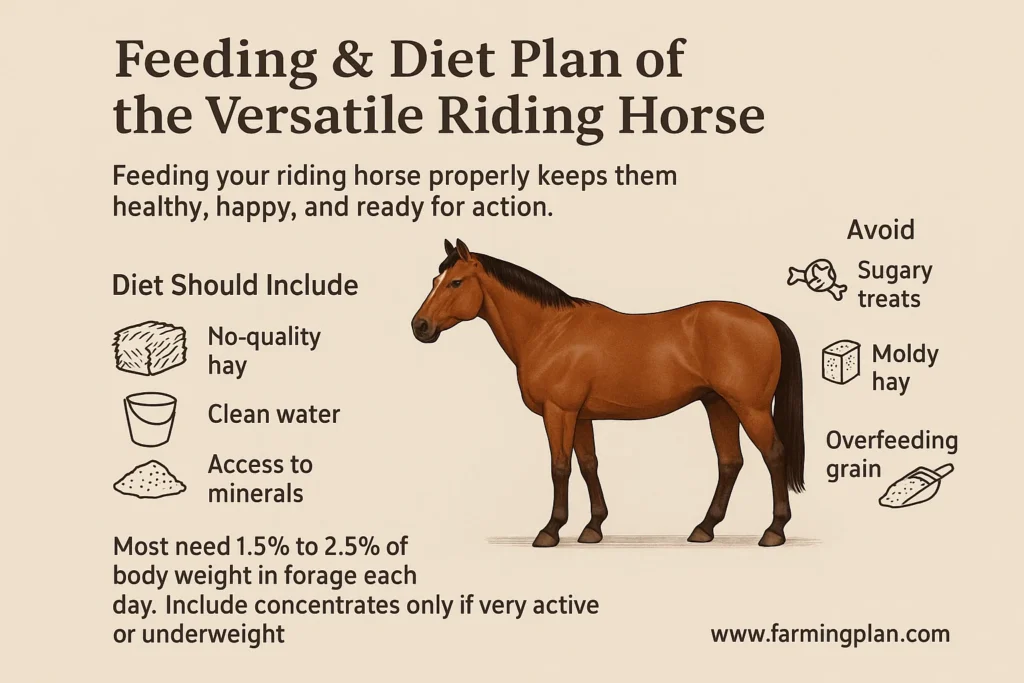A versatile riding horse is more than just a good mount. It’s a dependable partner for riders of all levels, styles, and goals. Whether you’re enjoying a peaceful trail ride, training for a Western pleasure event, or tackling a ranch cow work challenge, the right horse can handle it all. These horses offer comfort, confidence, and control—ideal for young beginners or seasoned cowboys alike. With qualities like calm temperaments, smooth gaits, and strong bodies, they shine across various riding classes. In this article, we’ll explore what makes these horses so special, how to care for one, and how to find your perfect match. Saddle up—we’re going on a ride into the world of versatile riding horse.

History & Origin of the Versatile Riding Horse
The story of the versatile riding horse starts on the American ranch. Early settlers needed tough, agile horses for herding cattle, covering long distances, and managing rough terrain. These demands shaped breeds like the American Quarter Horse, known for its strength, speed, and intelligence. Over time, their reputation grew beyond the ranch. They became stars in show rings, trail rides, and even racing. Other breeds like the Morgan, Arabian, and American Saddlebred also proved their ability to excel in multiple disciplines. Organizations like the American Quarter Horse Association (AQHA) played a key role in recognizing these all-around talents.

Their competitions, including the AQHA Versatility Ranch Horse Program and World Show, celebrate the horse’s ability to handle varied challenges—from ranch work to pleasure riding. Even today, horses that succeed in events like trail riding, stock work, and Western performance show the lasting value of a versatile partner.
Characteristics of the Versatile Riding Horse
A versatile riding horse stands out with its compact, well-muscled body, smooth movements, and balanced frame. These horses have a solid build, strong legs, and a calm yet alert expression. Coat colors and patterns vary widely, with many showcasing classic shades like chestnut, bay, or palomino. Their cadenced gaits make for a smooth ride, and they respond well to both rein and leg cues.

You’ll often find them outfitted in plain leather tack that supports Western disciplines like ranch riding. They’re known for clean transitions, steady pacing, and easy adaptability between gaits. Their ability to maintain a centered balance and shift weight smoothly helps riders of all skill levels maintain comfort and control. Whether you’re in a conformation class or on a trail ride, these horses are ready to shine.
Read more: Oldenburg Horses: The Strength and Elegance You Never Expected in a Single Breed
Temperament
Temperament is key when choosing a horse, especially for families, first-time riders, or competitive youth. Versatile riding horses are known for their calm, cooperative nature. They’re quick learners who bond easily with their riders, making them ideal for both daily riding and ranch versatility competitions. Their dependable mindset allows riders to explore new challenges without fear. Versatile riding horses horses aren’t just calm—they’re also brave and willing. Whether you’re in a new environment or navigating cattle work, their consistent behavior builds rider confidence. Riders say it feels like “having a teammate you can trust.” From arena shows to quiet country paths, a horse with a solid temperament makes every ride smoother and more enjoyable.
Feeding & Diet Plan
Feeding your riding horse properly keeps them healthy, happy, and ready for action. Their diet should include plenty of high-quality hay, clean water, and access to minerals. Most need between 1.5% to 2.5% of their body weight in forage each day. Include concentrates or grains only if your horse is very active or underweight. Always make diet changes slowly to avoid upsetting their digestion.

Avoid sugary treats, moldy hay, or overfeeding grain, which can lead to colic or laminitis. Adjust portions based on age, body condition, and activity level. Horses in heavy use—such as those doing trail riding or ranch work—may need additional calories and electrolytes. Regularly check your horse’s body score and talk to a vet to keep the feeding plan on track.
Read more: Dutch Warmblood Horse: Don’t Be Fooled by Myths Here’s Why They’re Perfect for You
Usage
Versatile riding horse can do it all—from daily rides to championship classes. They’re used in Western pleasure, endurance riding, competitive trail riding, and ranch horse events. Riders appreciate their ability to adjust between tasks like cow work, trail patterns, or basic equitation classes. These horses often win all-around versatility ranch horse titles because of their broad skillset. For those who just want to enjoy a ride, versatile riding horses are perfect too. Their steady pace, calm nature, and easy communication style make them a favorite for families and hobby riders. Whether you’re guiding cattle or cruising through the woods, a versatile riding horse is up for the challenge.
Choose A Horse That Matches Your Heart—Not Just Your Saddle.
Special Features
One standout trait is their smooth gait—comfortable for long rides and easy on a rider’s joints. They transition between speeds with ease, thanks to their timely transitions and ability to yield to contact. They’re often trained to perform both Western and English maneuvers, making them suitable for multi-discipline riders. Their body structure, including adequate muscling and a low center of gravity, helps with balance and power. Some can even perform advanced tasks like opening gates or maneuvering tight turns on a ranch trail pattern. These traits make them stars in both casual and professional settings.
Health Issues & Prevention
Every horse needs regular care, and versatile riding horse are no exception. Common health problems include hoof issues, joint pain, and digestive disorders. Laminitis, arthritis, and colic are among the most serious but can often be prevented. Ensure clean water, a balanced diet, and proper hoof care. Schedule regular vet visits for dental checks, vaccinations, and deworming. Keep your horse active, but avoid overworking. A clean stall, safe pasture, and regular grooming all help prevent infections and skin problems. Watch your horse’s behavior closely; changes in eating, gait, or attitude often signal a health concern.
Read more: Discover the Incredible World of the Quarter Horse
Step-by-Step Versatile Riding Horse Owner’s Guide
Owning a versatile riding horse means more than just having a saddle and bridle—it’s about building a solid, lasting partnership. Whether you’re a beginner or an experienced rider, this step-by-step care guide will help you raise a responsive and well-mannered horse ready for any riding style.
Step 1: Choose the Right Breed for Versatility
Start your journey by picking a horse breed known for being adaptable, smart, and calm. The American Quarter Horse is a top choice thanks to its strength, cooperative temperament, and history in ranch riding and Western disciplines. Other excellent breeds include Morgans, Arabians, and American Saddlebreds, all known for their versatility and balanced riding position.
Look for:
- A compact, well-muscled frame
- Calm eyes and an alert expression
- Smooth, cadenced gaits
- A willing attitude during handling
Buying from an AQHA-certified breeder or a trusted training center like Braden Training Center can help ensure the horse is well-trained and fit for multiple riding styles.
Step 2: Prepare a Safe and Comfortable Environment
A healthy horse needs a clean, secure space to live and move freely. Set up:
- A well-ventilated stall with soft bedding
- Fencing that’s sturdy and free of sharp edges
- Access to pasture for exercise and grazing
- Plenty of fresh water and a shaded area for hot days
Use plain leather tack for training comfort, especially for new horses transitioning to trail riding or Western pleasure events. Keep equipment clean and properly fitted to avoid injury or discomfort.
Step 3: Teach Basic Groundwork and Handling
Before you ever sit in the saddle, your horse should trust you on the ground. Use groundwork to teach:
- Leading on a halter
- Backing up on command
- Yielding to contact from pressure on the lead or body
- Standing still during grooming and tacking up
These lessons build respect and communication between horse and rider. Groundwork creates a foundation for safe and effective riding, especially for first-time riders or those training for basic equitation classes.
Step 4: Feed and Groom Daily for Long-Term Health
Nutrition plays a major role in your horse’s behavior and performance. Feed your horse:
- High-quality hay or pasture (1.5–2.5% of body weight)
- Fresh water at all times
- Salt blocks or mineral supplements for hydration and balance
- Grains only if needed for weight gain or high performance work
Avoid:
- Moldy feed
- Excessive grain
- Sudden diet changes
Groom daily to check for:
- Cuts or swelling
- Signs of skin infections or parasites
- Changes in coat or behavior
This regular care also helps maintain your horse’s bond with you. A clean, healthy coat and trimmed hooves reflect good health and attention.
Step 5: Begin Riding with Clear, Gradual Sessions
Once groundwork is consistent, start riding with short, calm sessions. Focus on:
- Walking in a straight line
- Turning smoothly
- Stopping with light rein or voice cues
- Backing up without resistance
Keep lessons short (20–30 minutes) and repeat key basic handling maneuvers daily. Use positive reinforcement and avoid overwhelming your horse with new commands too quickly.
As skills grow, move into:
- Ranch trail patterns
- Cow work simulations
- Smooth gait transitions
Stay patient and build your horse’s confidence through repetition and trust.
Step 6: Maintain Health with Routine Checks
Healthy horses perform better and stay more responsive under saddle. Build a daily and monthly care routine:
- Pick hooves before and after each ride
- Check legs and joints for swelling
- Monitor appetite and behavior for early signs of illness
Schedule regular:
- Vet visits for dental care, vaccines, and wellness checks
- Farrier visits every 6–8 weeks for hoof trims or shoeing
- Deworming and fly control to prevent common irritants
Keep a written log of health notes, weight changes, and training progress. This helps spot patterns and address small problems before they grow.
Step 7: Join Local Events and Classes to Practice Skills
Once your horse has a solid base, take your training further by joining local shows or clinics. Look for:
- Cow work classes like box-drive-box
- Trail ride competitions
- Beginner and championship classes in Western disciplines
- Class sheets that include your horse’s strongest areas, such as conformation or ranch versatility
These events help reinforce your horse’s training and boost your confidence as a rider. They also introduce your horse to new environments—an important step in building a true all-around versatility ranch horse.
Expert Tips & Best Practices
- Train with consistency and positive reinforcement.
- Use plain leather tack for comfort and minimal distractions.
- Practice box-drive-box patterns to build flexibility.
- Learn from centers like Braden Training Center for advanced techniques.
- Always prioritize safety—for both horse and rider.
Tip: A Responsive Horse Comes From Repetition And Trust—Train Every Day Like It’s Show Day.
Where to Buy a Versatile Riding Horse
Look for reputable sellers through AQHA-certified breeders, horse auctions, or equestrian platforms. Visit in person when possible to check health, training, and temperament. Ask for a trial ride. Review the class sheet and class definitions if you plan to compete. Look for horses that match your intended riding style and comfort level.
FAQ
What is the best breed for a versatile riding horse?
The American Quarter Horse is often the top choice, but Morgan’s and Arabians are also great for versatility and ease of training.
At what age is a horse considered versatile for riding?
Most horses show full versatility between 5 to 10 years of age, once they’ve matured physically and mentally.
Can versatile riding horse compete in both Western and English disciplines?
Yes, many versatile riding horse perform well in both, especially when trained gradually in each style.
How often should I train my versatile horse?
Aim for 4–5 times a week with rest days. Keep sessions varied to improve responsiveness and reduce boredom.
Are these horses good for beginners or children?
Yes, their calm temperament and easy-going nature make them ideal for young or first-time riders.
Conclusion
Versatile riding horse are incredible partners—strong, intelligent, and adaptable to many riding styles. With proper care, consistent training, and patience, these horses grow into more than just mounts; they become trusted friends who respond to your needs. Whether you seek success in competitive events like ranch versatility classes or simply enjoy relaxing trail rides, a well-trained versatile riding horse meets every challenge with grace and willingness. By choosing the right horse and dedicating yourself to its well-being, you’ll build a rewarding bond that lasts for years. Ride confidently and enjoy every moment with your versatile riding horse.


